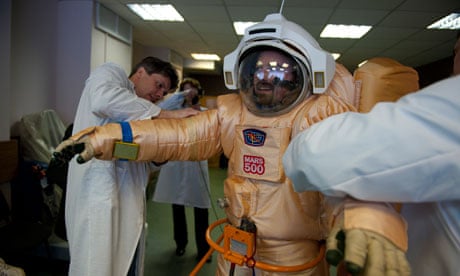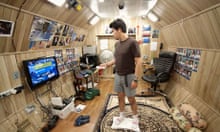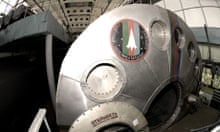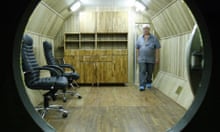After a year of strenuous astronaut training, six men will clamber into a capsule tomorrow afternoon for a journey like no other. Their mission? To boldly go – well, nowhere.
The men, who were chosen from thousands of highly qualified applicants, are the crew for a simulated round-trip to Mars, a mission that requires them to be sealed for 520 days inside a mock-up spaceship that sits in a Moscow car park.
The European Space Agency (Esa) experiment, called Mars 500, is designed to explore how humans cope with the stress, confinement and severely limited company that will confront future astronauts on missions to the farthest reaches of the solar system.
To keep the would-be astronauts on their toes, agency officials will simulate equipment failures and medical emergencies. Regular medical checks and psychological appraisals will reveal how well – or how badly – the men are faring.
The crew, three Russians, two Europeans and one Chinese, will spend most of their 18-month stay in the "habitable module" of the spaceship, a steel capsule the size of a bendy bus that has six sparsely furnished bedrooms built into it.
Another capsule attached to the living quarters contains a gym, an artificial greenhouse and space for supplies such as food and water. A third capsule is the medical room.
On being selected, 27-year-old Italian-Colombian engineer, Diego Urbina, said he was excited, but added: "I'm slightly worried about the unexpected things, mainly psychological, that may happen during the isolation." Another crew member, Russian cosmonaut Alexei Sitev, tied the knot earlier this year with bride Ekaterina Golubeva. The prospect of spending the first year and a half of married life away from his wife was "very tough", he told reporters.
Simonetta di Pippo, Esa's director of human spaceflight, said the men were "brave" for taking part in the "history-making experiment" and praised them for willingly giving up so much of their time.
The crew will spend 250 days performing flight tasks and experiments on their "journey to the Red Planet" before climbing into a mockup of a landing module, from which they will step out in spacesuits onto a simulated Martian surface. After 30 days working on the surface – essentially a large sandpit – the crew face a 240-day "return trip".
The only contact the men will have with the outside world will be via a radio link to the space agency's "ground control" staff. To make the trip more realistic, their conversations will have a built-in time delay of up to 20 minutes: the time it takes for radio signals to reach Mars from Earth.
Nick Kanas, a psychiatrist at the University of California, San Francisco, who has studied astronauts on the international space station and the Russian Mir station, said the crew face a tough time.
"It's not unheard of for people to be confined and isolated for a long period, but it wears on you. You get tired of hearing the other guys' stories all the time. You run out of stimulating conversation after a few months. They will need constantly to find new things to talk about and to keep themselves interested," he said.
Space agencies have simulated long missions before, though not always successfully. An experiment at the same Moscow facility in 1999 descended into chaos when a Russian captain forced a kiss on a female Canadian crew member, and two other Russians got drunk and ended up in a fist fight that left blood spattered over the capsule walls.
"People in space tend to do the same things that people on the ground do," said Professor Kanas. "They're better able to deal with stress, but they also have more stress to deal with."





